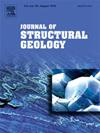Structural architecture, tectonic stacking and extensional reactivation of nappe contacts in the southern Middle Tuscan Ridge, Inner Northern Apennines orogenic belt (Italy)
IF 2.9
2区 地球科学
Q2 GEOSCIENCES, MULTIDISCIPLINARY
引用次数: 0
Abstract
Interpreting tectonic stacking patterns and the nature of contacts between tectonic units is a major challenge in orogenic belts, particularly when mafic rock slices are embedded within the tectonic stack. These occurrences raise fundamental questions about their origin and the tectonic processes responsible for their emplacement. Such complexities, which characterize several orogenic belts worldwide, are especially prominent in the inner Northern Apennines orogenic belt (Italy). This belt is characterized by abrupt metamorphic discontinuities, local omissions of portions of the tectonic stack, significant stratigraphic gaps within individual tectonic units and contains discontinuous mafic bodies within the nappe pile. These features point to a polyphase tectonic evolution, which over the last decades has led to a range of hypotheses concerning the Neogene evolution of the inner Northern Apennines. Testing these models requires integrated structural, petrological, and stratigraphic investigations. This study presents structural, kinematic and stratigraphic data on detailed field mapping in the southern Middle Tuscan Ridge (southern Tuscany), a key area within the inner Northern Apennines. Our results document a polyphase extensional evolution characterised by the sequential development of normal faults during post-orogenic deformation (∼19–20 Ma). Based on this evidence, we propose an updated tectonic model that integrates the geometry, timing, and evolution of extensional structures in this part of the chain. The model refines the regional tectonic framework and provides a basis for further investigation into the metamorphic evolution, the chronology of tectonic events, and the origin of mafic bodies within continental units. On a broader scale, it offers a reference for interpreting post-collisional extensional settings in other orogenic belts worldwide.
意大利内北亚平宁造山带中托斯卡纳岭南部构造构型、构造叠加与推覆接触的伸展活化
解释构造叠加模式和构造单元之间接触的性质是造山带的主要挑战,特别是当基性岩片嵌入构造叠加中时。这些事件提出了关于它们的起源和造成它们就位的构造过程的基本问题。这种复杂性是世界上若干造山带的特征,在北亚平宁造山带(意大利)内尤为突出。该带的特点是变质不连续性突变,构造叠层局部遗漏,个别构造单元内有明显的地层缺口,推覆桩内含有不连续的基性体。这些特征表明了一个多阶段的构造演化,在过去的几十年里,这导致了一系列关于亚平宁北部内部新近纪演化的假设。测试这些模型需要综合的构造、岩石学和地层学调查。本文介绍了在北亚平宁山脉内部的一个关键区域——中托斯卡纳山脊南部(托斯卡纳南部)进行的详细野外测绘的构造、运动学和地层资料。我们的研究结果记录了一个多阶段的伸展演化,其特征是在造山后变形期间(~ 19-20 Ma)正断层的顺序发育。基于这些证据,我们提出了一个更新的构造模型,该模型整合了这一部分伸展构造的几何形状、时间和演化。该模型细化了区域构造格架,为进一步研究变质演化、构造事件年代学和大陆单元内基性体的起源提供了基础。在更大的尺度上,为解释世界上其他造山带的碰撞后伸展环境提供了参考。
本文章由计算机程序翻译,如有差异,请以英文原文为准。
求助全文
约1分钟内获得全文
求助全文
来源期刊

Journal of Structural Geology
地学-地球科学综合
CiteScore
6.00
自引率
19.40%
发文量
192
审稿时长
15.7 weeks
期刊介绍:
The Journal of Structural Geology publishes process-oriented investigations about structural geology using appropriate combinations of analog and digital field data, seismic reflection data, satellite-derived data, geometric analysis, kinematic analysis, laboratory experiments, computer visualizations, and analogue or numerical modelling on all scales. Contributions are encouraged to draw perspectives from rheology, rock mechanics, geophysics,metamorphism, sedimentology, petroleum geology, economic geology, geodynamics, planetary geology, tectonics and neotectonics to provide a more powerful understanding of deformation processes and systems. Given the visual nature of the discipline, supplementary materials that portray the data and analysis in 3-D or quasi 3-D manners, including the use of videos, and/or graphical abstracts can significantly strengthen the impact of contributions.
 求助内容:
求助内容: 应助结果提醒方式:
应助结果提醒方式:


